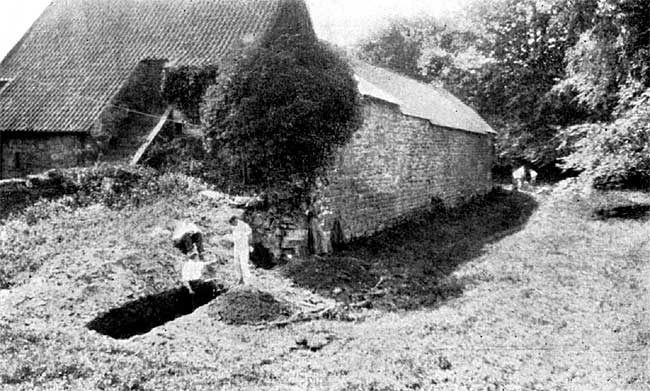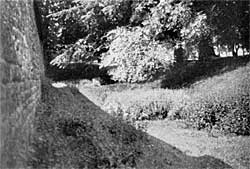Greasley Castle
By Herbert Green, B.A.

Greasley Castle, 1933.
MOST guides and general histories of Nottinghamshire make mention of Greasley Castle. Many record little more than the grant of the licence to crenellate made by Edward III. to Nicholas de Cantelupe in 1340. A few go further and give a more detailed account of some aspect or other of the castle's history. Thoroton1 for example, mentions the owners of Greasley down to his own time with some description of their descent. The Victoria County History of Nottinghamshire (Vol. II, p. 311) provides an excellent account of the earthworks and fishponds which may still be traced near the castle. The History of Nottinghamshire by Cornelius Brown (1896)2 gives a good description of Greasley Castle and its builder. Another book which must be mentioned is Griseleia; Snotinghscire by Rodolph Baron von Hube (1901). Since this volume was published ideas on many subjects have changed. But, while the references to the general history of England and the interpretation of place-names given in this book, cannot now be accepted, the account of the life of Nicholas de Cantelupe, with the sources of information indicated, remains a valuable contribution. The illustrations are distinctly helpful, but the description of the castle, although containing some useful information, is not convincing.
In view of the existence of a considerable amount of literature on this subject, it seems desirable to give reasons for the writing of this article. The original purpose was to describe the results of excavation attempted, although on a very small scale, in the summer of 1933. In addition it is hoped that the article will be useful in attempting to answer a number of questions which arise concerning Greasley Castle, and which so far have not been seriously tackled by any writer. Throughout, an attempt has been made to discover how the history of the castle may be used to illustrate important movements in the general history of England for in this, perhaps, the greatest value of the study of local history lies.
The licence to fortify Greasley came at a time when the building of castles was beginning to decline.3 The foundation of true castles was a comparatively rare thing in the 14th and 15th centuries, and in a number of crenellated houses the fortification was very slight, and at times little more than ornamental. The baronial castle was becoming an anachronism. That the invention of gunpowder was one reason for this decline can scarcely be denied, but the effect of this discovery was perhaps more gradual than was at one time supposed. Apart from the castle’s reduced effectiveness owing to the use of artillery, there was a tendency for it to decline in importance in the military organisation of the country. Changes in the art of war tended to give the military advantage to the side which could put into the field and handle effectively the largest masses of men-at-arms. Edward I., for example, had developed an infantry very efficient in missile tactics. This development combined with the complete independence from the feudal levy, gave to the king, the person best able to pay, an advantage over the barons, and played an important part in the suppression of militant feudalism, and in rendering the baronial castle an anachronism.

Greasley Castle, 1933.
When, in the 14th and 15th centuries massive fortresses no longer served a useful purpose, men took the opportunity to escape the extreme discomfort which these castles inflicted upon their occupants. Earlier castles were sometimes altered to provide greater comfort, but where practicable, the fortified manor house was preferred to the castle. At Tretower4 in Wales the remains of a 14th century fortified house may be seen within a short distance of the ruined castle which it superseded. Although Greasley was dignified by the name of castle it was probably little more than a fortified manor house. The wording in the Calendar of Patent Rolls5 runs, “Licence to Nicholas Cantelupe to crenel-late his dwelling place of Gryseleye co. Notts.” Thoroton6 in recording the granting of the licence to Nicholas “to strengthen or fortify his manor house,” remarks, “from this time it was called a castle.” As a 14th-century fortified house it is probably more important and interesting than it would have been as a castle; for although in one sense the beginning of the development of the larger type of English house7 lies in the Norman keep, the fortified house marks the earliest development of the truly domestic architecture. Viewed in this light, Greasley Castle takes on the character of an early example of a fortified manor house, and the starting point of the growth of the larger type of English house, a growth continued through Haddon Hall, South Wingfield Manor, Tattershall Castle, and Wollaton Hall, to name a few examples in Nottinghamshire and adjacent counties.
(1) Throsby's edition of Thoroton, Vol.
II, p. 239, et seq.
(2) p. 240.
(3) See The Development of the Castle in England and
Wales, F. M. Stenton. Historical Association Leaflet No. 22 (1910, reprinted 1933). Military
Architecture in England in the Middle Ages, A. Hamilton Thompson;
Oxford University Press, 1912.
(4) For a picture of this, see London Illustrated News, July
7th, 1934.
(5) Calendar of Patent Rolls, Edward III., Vol. IV, 1338-1340.
(6) Throsby's edition, Vol. II, p. 240.
(7) See The Growth of the English House, J. A. Gotch, 1909 (Batsford),
p. 24.
